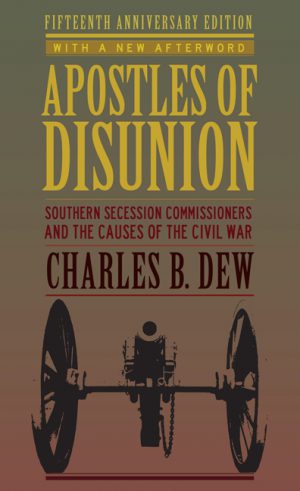“The Civil War was fought over what important issue?”
That question begins and ends the 2001 edition of Charles B. Dew’s Apostles of Disunion. It appeared on a test administered to prospective citizens by the U.S. Immigration and Naturalization Services. According to the INS, either “slavery” or “states [sic] rights” was an acceptable answer. This binary option, in Dew’s words, “reflects the deep division and profound ambivalence in contemporary American culture over the origins of the Civil War.”
Today, the U.S. Citizenship and Immigration Services administers the test. The current version of that test, updated in January 2017, includes this question: “Name one problem that led to the Civil War” (emphasis in original). Acceptable answers include “slavery,” “economic reasons,” and “states’ rights.” After 152 years, Americans still don’t agree on the cause of the Civil War.
There is a sense in which the second and third answers are correct. The election of Abraham Lincoln in November 1860 alarmed the South. Southerners feared that a Republican administration would violate their states’ rights and harm their economies in the process. Because they couldn’t see a way of keeping their states’ rights inviolate and their economies flourishing with Lincoln in the White House, they seceded.
And yet, citing “states’ rights” and “economic reasons” as causes of the Civil War is also profoundly misleading. Think of it this way: Why did Southerners think a Republican administration threatened their states’ rights and economies? Because they felt that Lincoln and the Republicans would interfere with their “peculiar institution,” slavery—the source of their region’s economic wealth and the reason for the constant invocation of states’ rights against federal power. Economic reasons and states’ right might have been proximate causes, but slavery was the ultimate cause.
The South seceded from the Union in order to defend the ideology of white supremacy and the practice of slavery. Next time you read about a conflict regarding a Confederate monument or the Confederate battle flag, keep that fact in mind.
But don’t take either my word or Charles B. Dew’s word for this conclusion. Take the word of the various men profiled in his book, men specifically commissioned by Southern states (e.g., South Carolina) to advocate the need for other Southern states (e.g., Virginia) to secede from the Union and form a new Confederacy, an advocacy that occurred in late 1860 and early 1861, prior to the attach on Fort Sumter. “Over and over again,” Dew writes, “they called up three stark images that, taken together, constituted the white South’s worst nightmare.”
Below are the “three stark images” together with representative quotes from secessionist commissioners:
- Racial equality
“Our fathers made this a government for the white man, rejecting the negro, as an ignorant, inferior, barbarian race, incapable of self-government, and not, therefore, entitled to be associated with the white man upon terms of civil, political, or social equality” (William L. Harris, Mississippi commissioner, in a December 1860 speech to the Georgia legislature).
- Race war
“Under the policy of the Republican party, the time would arrive when the scenes of San Domingo and Hayti, with all their attendant horrors, would be enacted in the slaveholding States” (William Cooper, Alabama commissioner, in a December 1860 speech to the Missouri legislature. He was referring to the Haitian Revolution (1791–1804), in which Haitian slaves overthrew their French masters.)
- Racial amalgamation
“Therefore it is that the election of Mr. Lincoln cannot be regarded otherwise than a solemn declaration, on the part of a great majority of the Northern people, of hostility to the South, her property, and her institutions [i.e., slavery]; nothing less than an open declaration of war, for the triumph of this new theory of government [i.e., “the equality of the races, white and black”] destroys the property of the South, lays waste her fields, and inaugurates all the horrors of a San Domingo servile insurrection [i.e., the Haitian Revolution], consigning her citizens to assassinations and her wives and daughters to pollution and violation to gratify the lust of half-civilized Africans” (Stephen F. Hale, Alabama commissioner, in a December 27, 1860, in a formal letter to Gov. Beriah Magoffin of Kentucky).
In his 2016 Afterword, Dew notes that he reviewed the commissioners’ speeches and formal letters afresh and saw with greater clarity how “economic themes formed a significant undercurrent in their case for secession.” But once again, those economic reasons focused on slavery. After quoting various commissioners, Dew notes: “The two largest industries in the Old South were staple crop agriculture and the [internal] slave trade. No other economic activity came even close to these two enterprises. So they had to figure in the secession commissioners’ argument, and they did.”
With the defeat of the South and the abolition of slavery, Southern partisans recast the ultimate cause of their struggle. The result was the so-called “Lost Cause,” the defense of Southern culture in which the centrality of slavery was downplayed. In light of what secession commissioners said about the cause of their struggle before the Civil War, however, the Lost Cause can only be seen as egregious historical revisionism. The South seceded from the Union in order to defend the ideology of white supremacy and the practice of slavery. That was its ultimate aim and the reason for its invocation of “states’ rights” and “economic reasons.”
Next time you read about a conflict regarding a Confederate monument or the Confederate battle flag, keep that fact in mind.
Book Reviewed:
Charles B. Dew, Apostles of Disunion: Southern Secession Commissioners and the Causes of the Civil War, 15th anniv. ed. (Charlottesville: University of Virginia, 2016).
_____
P.S. If you found my review helpful, please vote “Yes” on my Amazon.com review page.

